Chapter 6: Energy Resources and Consumption
6.1: Introduction to Energy
- Energy: Defined as the fundamental entity of nature that is transferred between parts of a system in the production of physical change within the system and is usually regarded as the capacity for doing work.
- Sun: The source of energy for most of life on Earth.
- It is heated to high temperatures by the conversion of nuclear energy to heat in its core by the process of nuclear fusion.
- Human civilization requires energy to function. Humans obtain energy from resources such as fossil fuels, nuclear fuel, or renewable energy.
Forms of Energy
- Chemical energy: It is stored in bonds between atoms in a molecule.
- Electrical energy: It results from the motion of electrons.
- Electromagnetic energy: This energy travels by waves.
- Mechanical energy: Consists of potential and kinetic energies.
- Potential Energy: Stored energy in any object.
- Kinetic energy: Energy in motion.
- Nuclear energy: It is stored in the nuclei of atoms, and it is released by either splitting or joining atoms.
- Thermal Energy: the energy an object has because of the movement of its molecules.
Units of Energy/Power
- British thermal unit (Btu): It is the amount of heat required to raise the temperature of 1 pound of water by 1°F.
- Btu/hr: A ton in many air conditioning applications.
- Horsepower (HP): Used in automobile industries.
- 1 HP = 746 watts
- Kilowatt hour (kWh): A unit of power; a measure of energy used at a give moment.
- A billing unit of energy delivered to consumers by electric utilities.
Law of Thermodynamics
- First Law of Thermodynamics: The law of conservation of energy; energy can't be created nor destroyed.
- Second Law of Thermodynamics: The total system work is always less than the heat supplied into the system.
- Zeroth Law of Thermodynamics: If a body A is in thermal equilibrium with another body B, and body A is also in thermal equilibrium with a body C, then this implies that the bodies B and C are also in equilibrium with each other.
6.2: Renewable and Nonrenewable Resources
- Renewable energy: Defined as energy that is collected from resources that are naturally replenished on a human time scale.
- %%Renewable energy resources exist over wide geographical areas%%, in contrast to other energy sources that are concentrated in a limited number of countries.
- Nonrenewable Energy Sources: Their use is not sustainable because their formation takes billions of years like fossil fuels.
- Arguments used to defend the continued use of fossil fuels include the following:
- Abundant supply, resulting in relatively low prices for consumers
- Concentrated fuel with a high net-energy yield
- Infrastructure already in place for extraction, processing, and delivery
- Politics
- Technology already exists for their use.
6.3: Fuel Types
- Fossil Fuels: Fuels formed from past geological remains of living organisms.
- Burning wood fuel: It creates the following by-products: carbon dioxide, heat, steam, water vapor, and wood ash.
- Peat: It is an accumulation of partially decayed vegetation or organic matter, mostly wetland vegetation like mosses, sedges, and shrubs, that forms in acidic and anaerobic conditions.
- Coal: Formed when dead plant matter that covered much of Earth’s tropical land surface at one time decays into peat and is then converted into coal by the heat and pressure of deep burial over millions of years.
- Lignite: Often called brown coal, is the type most harmful to human health and is used almost exclusively as the primary fuel for electric power generation around the world.
- Bituminous: Used primarily as fuel in steam-electric power generation.
- Anthracite: Used primarily for residential and commercial space heating.
- Clean Coal: Technology that attempts to mitigate emissions of carbon dioxide and other greenhouse gases that arise from the burning of coal for electrical power.
- Carbon capture and storage (CCS): Pumps and stores CO2 emissions underground.
- Natural gas: A fossil fuel formed when layers of buried plants and gases are exposed to intense heat and pressure over thousands of years.
- Oil: A fossil fuel produced by the decomposition of deeply buried organic material (plants) under high temperatures and pressure for millions of years.
- Cogeneration: Also known as combined heat and power (CHP), is an efficient technology to generate electricity and heat simultaneously at local facilities; otherwise, the heat produced from electricity generation is wasted.
Technologies used to remove pollutants from flue gases
Baghouse filters: Fabric filters that can be used to reduce particulates.
Burning pulverized coal at lower temperatures: Coal is crushed into a very fine powder and injected into a firebox.
Coal gasification: A process that turns coal and other carbon-based fuels into gas known as “syngas.”
- Impurities are removed from the syngas before it is combusted, which results in lower emissions of sulfur dioxide, particulates, and mercury.
Cyclone separator: A method of removing particulates through rotational (spinning) effects and gravity.
Electrostatic precipitator: A filtration device that removes fine particles, like dust and smoke, from a flowing gas using an electrostatic charge.
Fluidized-bed combustion: A method of burning coal in which the amount of air required for combustion far exceeds that found in conventional burners.
- This process can be used to reduce the amount of NOx, SOx, and particulates.
Scrubbers: Systems that inject chemical(s) into a dirty exhaust stream to “wash out” acidic gases.
- It can also be used to reduce SOx and particulates from burning coal.
Sorbents: Activated charcoal, calcium compounds, or silicates can convert gaseous pollutants in smokestacks into compounds that baghouse filters, electrostatic precipitation, or scrubbers can collect.

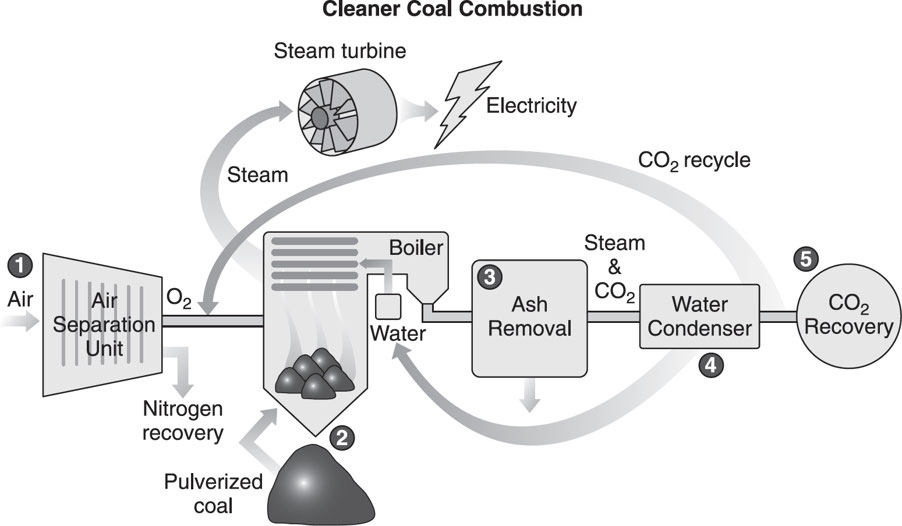
6.4: Fossil Fuels
Law of Supply: All other factors being equal, %%as the price of a good or service increases, the quantity of goods or services that suppliers offer will increase, and vice versa%%.
- As the price of an item goes up, suppliers will attempt to maximize their profits by increasing the quantity offered for sale.
Law of Demand: All other factors being equal, %%the quantity of the item purchased is inversely related to the price of the item.%%

Fossil fuels are formed over time from deposits of once-living organisms and take thousands of years to form.
Coal originally comes from land vegetation, which over millions of years decays and becomes compacted.
Natural gas was formed from the remains of marine organisms and is relatively abundant and clean when compared to coal and oil.
Oil is a liquid fossil fuel that formed from the remains of marine organisms, these deposits became trapped in small spaces in rock and sediment, which now can be accessed by drilling.
Other Fossil Fuel Nonrenewable Energy Resources
- Methane Hydrates (Clathrates): These are recently discovered source of methane that form at low temperature and high pressure.
- They are found:
- On land in permafrost regions;
- Beneath the ocean floor; and
- On continental shelves.
- Oil shale: An organic-rich, fine-grained sedimentary rock containing a solid mixture of organic chemical compounds (kerogen) from which liquid hydrocarbons (shale oil) can be produced.
- Synfuels: Any fuel produced from coal, natural gas, or biomass through chemical conversion.
- Tar sands: Contain bitumen—a semi-solid form of oil that does not flow. These are mined using strip mining techniques; in situ methods, using steam, can also be used to extract bitumen from tar sands.
Combustion
The combustion of any fossil fuel follows the following reaction:

Carbon dioxide produced during fossil fuel combustion for heat and electricity generation is a major contributor to global CO2 emissions considered responsible for global warming due to its greenhouse gas effect.
Steps Involved from Fuels to Electricity
- Extracting thermal energy from the fuel and using it to raise steam;
- Converting the thermal energy of the steam into kinetic energy in the turbine; and
- Using a rotary generator to convert the turbine’s mechanical energy into electrical energy.
Hydraulic Fracturing
- Hydraulic fracturing: Also known as “fracking,” is an oil and gas well development process that typically involves injecting water, sand, and chemicals %%under high pressure into a bedrock formation via a well%%.
- This process is %%intended to create new fractures in the rock%% as well as increase the size, extent, and connectivity of existing fractures.
- It is commonly used in low-permeability rocks like sandstone, shale, and some coal beds to increase oil and/or gas flow to a well from petroleum-bearing rock formations.
6.5: Nuclear Power
Nuclear Fission
During nuclear fission, an atom %%splits into two or smaller nuclei along with by-product particles%%.
- The reaction gives off heat.
If controlled, the heat that is produced is used to produce steam that turns generators that then produce electricity.
If the reaction is not controlled, a “meltdown” can result.
Nuclear Meltdown: A severe nuclear reactor accident that results in core damage from overheating.
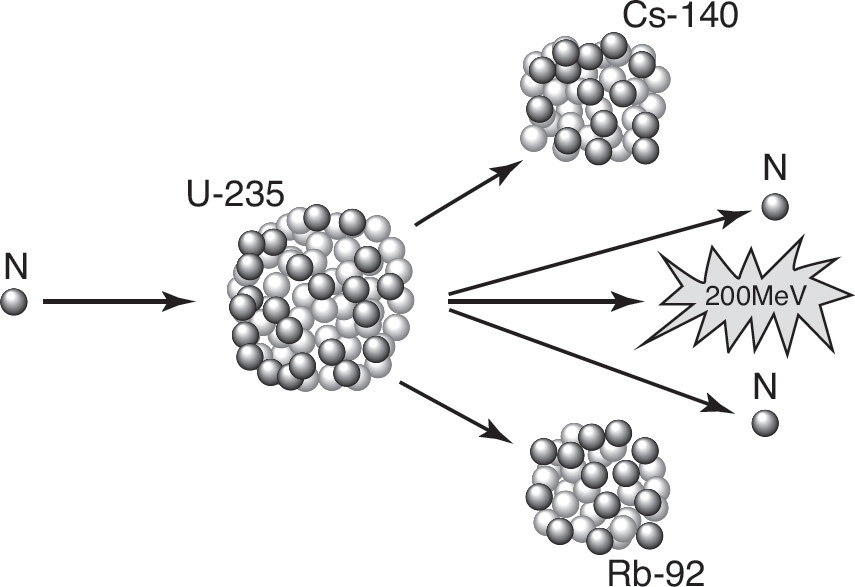
Nuclear Fuels
- U-235: Less than 1% of all-natural uranium on Earth.
- Critical Mass: The minimum amount of U-235 required for a chain reaction.
- U-238: The most common isotope of uranium and has a half-life of 4.5 billion years.
- When hit by neutron, it eventually decays into Pu-239.
- Pu-239: It has a half-life of 24,000 years and is produced in breeder reactors from U-238.
- Its fission provides about one-third of the total energy produced in a typical commercial nuclear power plant.
Nuclear Components
- Core: Contains up to 50,000 fuel rods.
- Each fuel rod is stacked with many fuel pellets.
- Fuel: Enriched (concentrated) U-235 is usually the fuel.
- The fission of an atom of uranium produces 10 million times the energy produced by the combustion of an atom of carbon from coal.
- Control rods: Move in and out of the core to absorb neutrons and slow down the reaction.
- Moderator: It reduces the speed of fast neutrons, thereby allowing a sustainable chain reaction.
- Coolant: Removes heat and produces steam to generate electricity.
6.6: Energy from Biomass
Biomass: It is biological material derived from living, or recently living, organisms that can be burned in large incinerators to create steam that is used for generating electricity.
- It can be grown on marginal land that is not suitable for agriculture.
Anaerobic digestion: A collection of processes by which microorganisms break down biodegradable material, in the absence of oxygen, to produce methane gas, which is then burned to produce energy.
- Reduces the reliance on coal and oil.
- Reduces the impact of land disturbances required for coal mining.
- Reduces the methane emissions from landfills that contribute to global warming.
Biofuel: A liquid fuel produced from living organisms.
- These are biodegradable, can be converted into biodiesel or bioethanol to power vehicles.
- It can be produced anywhere as opposed to fossil fuels.
- It is a renewable energy source.
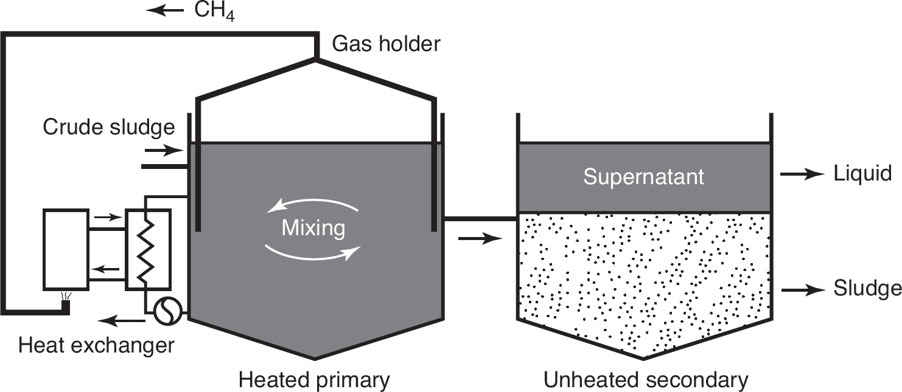
6.7: Solar Energy
Solar energy: It consists of collecting and harnessing radiant energy from the sun to provide heat and/or electricity.
- Electrical power and heat is generated at home and at industrial sites through photovoltaic cells, solar collectors, or at a central solar-thermal plant.
Passive solar heating: It does not include any type of mechanical heating device and functions by incorporating building features that absorb heat and then %%release it slowly to maintain the temperature throughout the building.%%
Active solar heating: It %%generates more heat than passive systems%%, and relies on three components: a solar collector to absorb the solar energy, a solar storage system, and a heat transfer system.
Residential photovoltaic system: It consists of solar panels to absorb and convert sunlight into electricity, a solar inverter to change the electric current from DC to AC, and a battery storage and backup system.

6.8: Hydroelectric Power
Dams: These are built to trap water, which is then released and channeled through turbines that generate electricity.
- Hydroelectric generation accounts for approximately 44% of renewable electricity generation, and 6.5% of total electricity generation in the United States.
- There are about 75,000 dams in the United States that block ~600,000 miles (~1 million km) of what had once been free-flowing rivers.
Advantages
- Dams result in habitat destruction.
- Dams help control flooding
- Long life spans
- Low operating and maintenance costs, which result in affordable electricity
- Moderate to high net-useful energy
- No polluting waste products
- Provide water storage for municipal and agricultural use
Disadvantages
- Dams are expensive to build.
- Dams create large flooded areas behind the dam from which people are displaced.
- Dams destroy wild rivers.
- Dams destroy wildlife habitats and keep fish from migrating.
- Dams reduce the amount of land available for agriculture.
- Sedimentation behind the dam requires dredging.
Floods can be caused by the following:
- Failures of dams, levees, and pumps
- Fast snowmelt
- Increased amounts of impervious surfaces, e.g., asphalt or concrete
- Natural hazards, such as wildfires, reduce the supply of vegetation that absorbs rainfall
- Prolonged heavy rainfall
- Severe winds over water
- Tsunamis
- Unusually high tides and storm surges
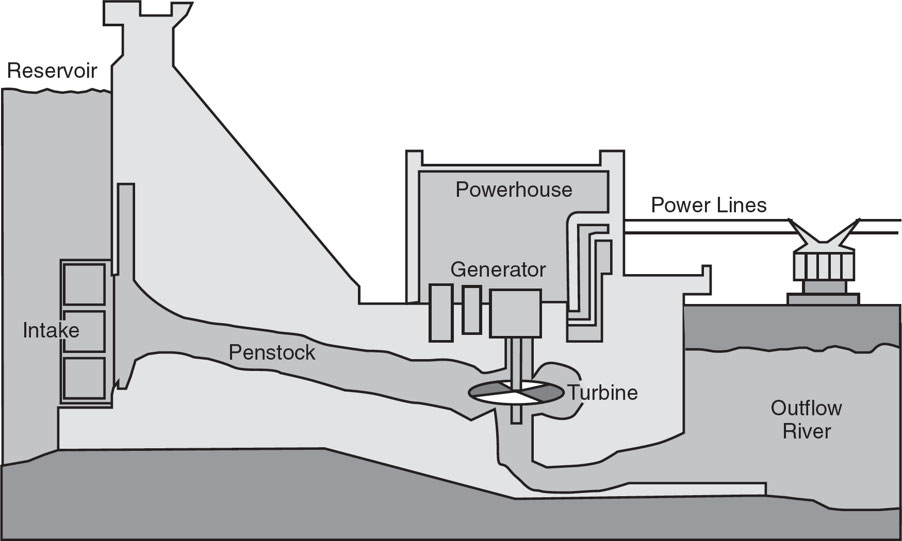
6.9: Geothermal Energy
Heat contained in underground rock and fluids from molten rock (magma), hot dry-rock zones, and warm-rock reservoirs %%produces pockets of underground steam and hot water that can be used to drive turbines%%, which can then generate electricity.
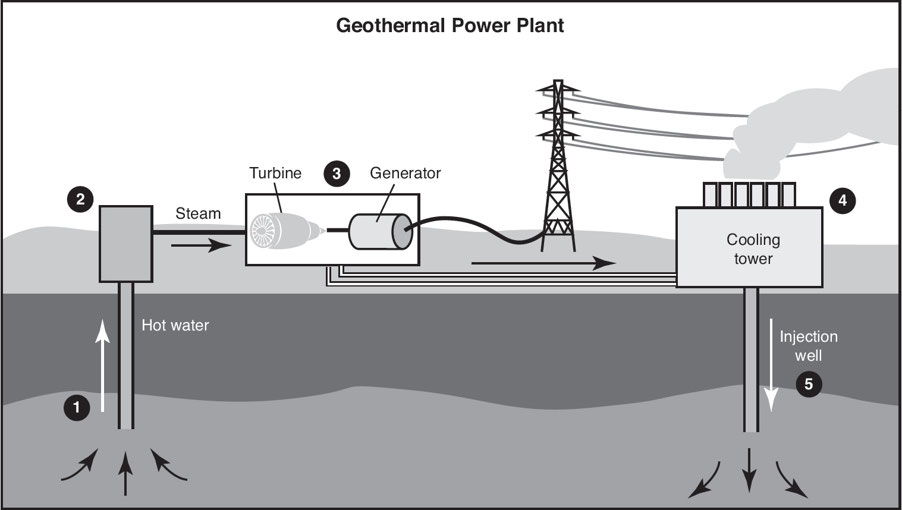
6.10: Hydrogen Fuel Cells
The hydrogen fuel cell operates similarly to a battery with two electrodes—oxygen passes over one and hydrogen passes over the other.
The hydrogen reacts with a catalyst to form negatively charged electrons and positively charged hydrogen ions (H+).
The electrons flow out of the cell to be used as electrical energy.
The hydrogen ions then move through a membrane, where they combine with oxygen and electrons to produce water.
Unlike batteries, fuel cells never run out.
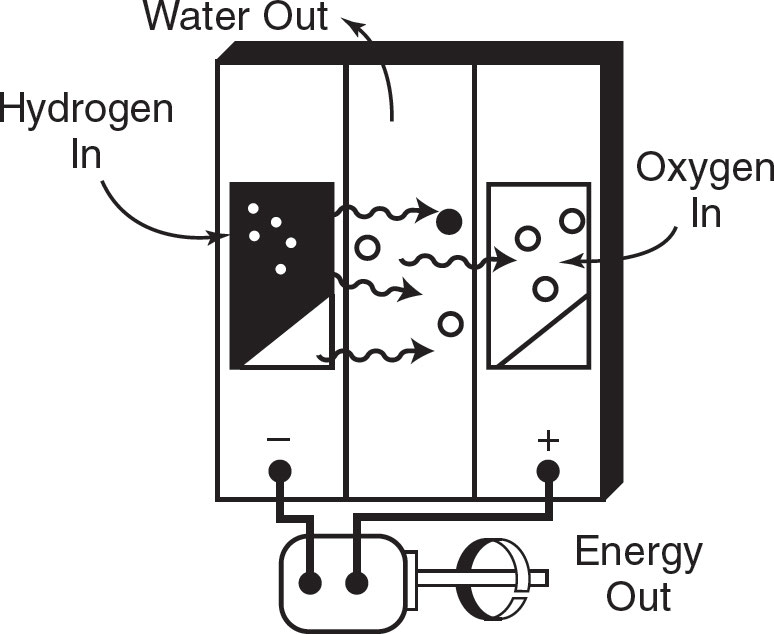
6.11: Wind Energy
Wind turbines work very simply: instead of using electricity to make wind—like a fan—wind turbines use wind to make electricity.
%%Wind turns the giant turbine blades, and then that motion powers generators%%.
Wind Farms: Wind turbines clustered together.
%%Using wind power is by far the most efficient method of producing electricity%%
One megawatt of wind energy can offset approximately 2,600 tons of CO2.
About 6% of the electrical demand in the United States is now produced from wind energy.
The current capacity of wind power in the United States powers approximately 20 million homes.
Offshore wind represents a major opportunity to provide power to highly populated coastal cities.
The largest turbines can harness energy to power 600 American homes.
The country with the largest wind energy installed capacity is China, followed by the United States.
There has been a 25% increase in wind turbine use in the last decade, but wind energy only provides a small percentage of the world’s energy.
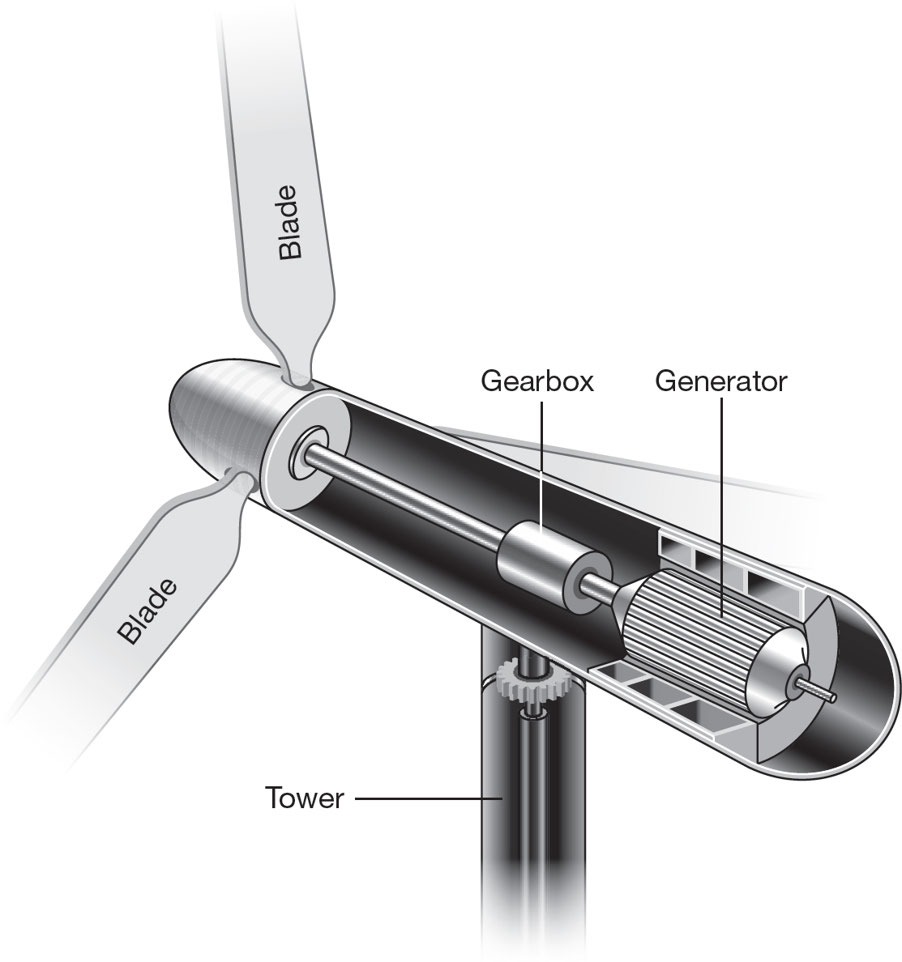
6.12: Energy Conservation
- Add extra insulation and seal air leaks.
- Improving attic insulation and sealing air leaks can save 10% or more on annual energy bills.
- Change to a programmable HVAC thermostat.
- A programmable thermostat can save as much as 15% on heating and cooling costs.
- Change to more efficient LED lighting.
- LED lights do not contain mercury and can be disposed of with the regular household trash.
- Minimize phantom loads.
- Phantom Load: Refers to the energy that an appliance or an electronic device consumes when it is not actually turned on.
- 75% of the electricity used to power home electronics is consumed while the products are turned off.
- Use more energy-efficient appliances.